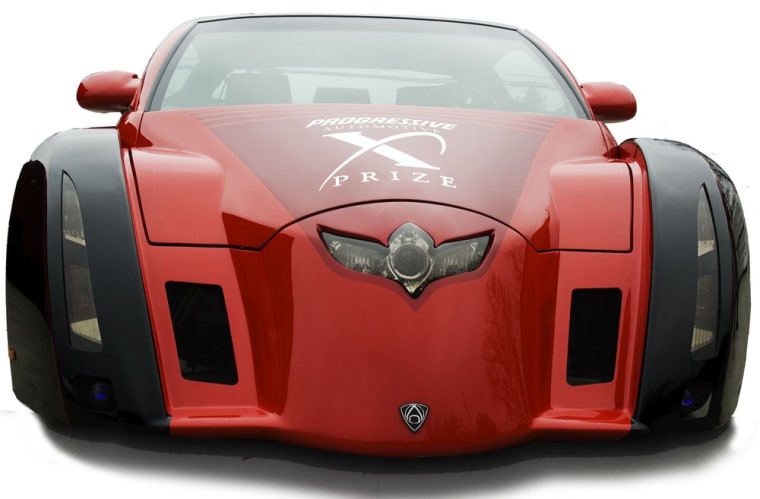The grandstands are empty and only a few crew members brave the blaring mid-summer sun and humidity to watch as the VLC (Very Light Car) turns one lap after another at Michigan International Speedway.
Finally, its tank drained, the car coasts to a stop, its driver emerging with a smile, and for good reason. The curious looking little vehicle has just leaped another hurdle, coming ever closer to a prize worth $5 million.
It’s down to the wire for the Progressive Insurance Automotive X-Prize, or PIAXP, a competition announced in April 2008 as a way to spur the development of clean, high-mileage vehicles. Funded to the tune of $10 million — which will eventually be divided among three separate categories — the event seems unexpectedly well-timed considering the way the BP Gulf oil spill has raised anew questions about America’s dependence on foreign oil.
“What we’re trying to do here is set the future, set the next level of efficiency for the automobile,” said Steve Wesoloski, one of the senior technical advisors on PIAXP.
On Tuesday, the foundation announced the results of an on-track competition, leaving nine vehicles from seven teams in the running. In the mainstream class, the Edison2 team's two VLC entries passed muster. In the alternative class it was Switzerland-based X-Tracer's two E-Tracer battery electric vehicles. And in the alternative class, side-by-side, these vehicles remained: Aptera's Aptera 2e; Li-ion Motors' Wave II; Raceabout Association's Raceabout; the TW4XP out of Germany; and ZAP's Alias. All of these cars run on an electric battery.
The X-Prize challenge drew an unexpectedly strong response; 115 teams entered 136 separate vehicles. They covered a wide range, from the relatively conventional to the truly exotic. Some entrants decided to bet on the time-tested internal combustion engine, focusing their efforts on other ways to improve efficiency.
That included Edison2, a team created by European car dealer Oliver Kuttner, who brought together an assortment of motorsports and defense specialists. His two identical entries into the $5 million Mainstream category are powered by ethanol-fueled Yamaha motorcycle engines. The real breakthroughs are in the lightweight and aerodynamic carbon fiber bodies and components. Each Very Light Car weighs in at just 750 pounds, despite having tight seating for four.
And then there were two
As the X-Prize nears the finish line, with only a few steps remaining before the winners are announced in Washington in September, the two VLCs are the only entrants left in the mainstream category.
“It’s theirs to win — or lose,” declared Eric Cahill, one of the senior competition organizers.
Cahill admits there have been some surprises in the two years since the PIAXP was first announced. For one thing, he notes, hybrid technology hasn’t delivered the knock-out many advocates had expected. Whether mated to a gas, diesel or ethanol powertrain, the touts early on thought hybrids would be the technology to beat. But, says Cahill, it’s looking more like hybrids are “a bridge technology,” until something better comes along.
In the two alternative vehicle categories — one for side-by-side two-seaters, the other for tandems — electric propulsion has been a dominant, though not an overwhelming force. The challenge, says Wesoloski, has been finding a way to squeeze in enough batteries to meet the X-Prize mandates.
Organizers early on decided they didn’t want to simply promote the development of some miracle technology that was too exotic or too costly to put into production. In the mainstream category, for example, a vehicle must seat four, meet all current federal safety standards, deliver a minimum 100 mpg — or the equivalent, using alternative power — travel 200 miles per charge or fill-up and, perhaps most challenging of all, teams must lay out a convincing business plan for putting an entry into moderately high-volume production.
That last obstacle alone tripped up many of the original X-Prize entrants.
For ZAP, the trials and tribulations have been worth it. Alex Campbell, one of the Santa Rosa, Calif.,-based electric vehicle maker's founders, said that win or lose, he’s betting his company will have a better chance of tagging along as bigger makers, like General Motors and Toyota, start pushing into the electric vehicle market.
“We’ve been on the outside looking in,” said Campbell, adding that during several recent shakedown events at the speedway about 80 miles west of Detroit he’s been able to make contact with conventional automotive suppliers who might be able to help him improve the way ZAP produces its battery cars.
Some controversy
The PIAXP hasn’t been without controversy, and there’s a good shot one of the oddest and most unlikely entrants could take the $2.5 million tandem prize. The Swiss-made X Tracer wouldn’t qualify as an automobile by most definitions. Even its developers concede it is little more than a motorcycle with a completely enclosed, egg-shaped body. But it just narrowly meets the requirements, says Wesoloski.
Will the Progressive Insurance Auto X-Prize live up to the grand vision of its sponsors?
“We’re not only hoping to accelerate the pace of change, but also serve as a broker of information to the consumer,” said Cahill.
When it was first announced, during the 2008 New York Auto Show, organizers likened the event to the Orteig Prize, which spurred Charles Lindbergh to make his trans-Atlantic solo flight, and the Ansara X-Prize which, in 2004, led to the first private manned space flight.
“When we first started we were getting criticized for making it seem too easy,” Cahill said.
While the initial number of entrants, suggests Cahill, underscored the power of the “competitive spirit,” the massive attrition rate has only underscored just how difficult it will be to make truly revolutionary improvements to the automobile.
